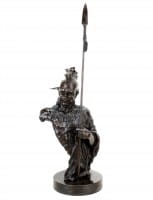Early Life and Education
Born on October 4, 1861, in Canton, New York, Remington was the only child of Seth Pierrepont Remington and Clarissa Bascom Sackrider. His father, a Civil War colonel and newspaper editor, instilled in him a love for horses and the outdoors. Remington's early education included attendance at the Highland Military Academy and later Yale University, where he studied art under John Henry Niemeyer. However, he left Yale after three semesters following his father's death.
Artistic Career and Western Depictions
Remington's fascination with the American West began with a trip to Montana in 1881. This experience inspired him to produce illustrations for publications like Harper's Weekly, capturing scenes of cowboys, Native Americans, and cavalrymen. His firsthand experiences in the West lent authenticity to his work, distinguishing him from other artists of his time.
Transition to Sculpture
In 1895, Remington ventured into sculpture, creating his first bronze piece, The Broncho Buster. This work marked the beginning of a new phase in his career, leading to the creation of 22 bronze sculptures. Notable pieces include The Rattlesnake and The Outlaw, which showcase dynamic movement and intricate detail.
Legacy and Influence
Remington's art played a significant role in shaping the perception of the American West during his time and continues to influence Western art today. His ability to convey the drama and vitality of frontier life has cemented his status as a pivotal figure in American art history.
Notable Works
- Paintings: A Dash for the Timber, The Scout: Friends or Foes?, The Hunters' Supper.
- Sculptures: The Broncho Buster, The Rattlesnake, The Outlaw.
Museums and Collections
Remington's works are housed in various institutions, including:
- Frederic Remington Art Museum: Located in Ogdensburg, New York, this museum offers a comprehensive collection of his works.
- Denver Art Museum: Houses several of Remington's sculptures and paintings.
- Metropolitan Museum of Art: Features a selection of his paintings and sculptures.
Frederic Remington's contributions to American art provide a vivid portrayal of the Old West, capturing the essence of a bygone era through his dynamic and detailed works.





